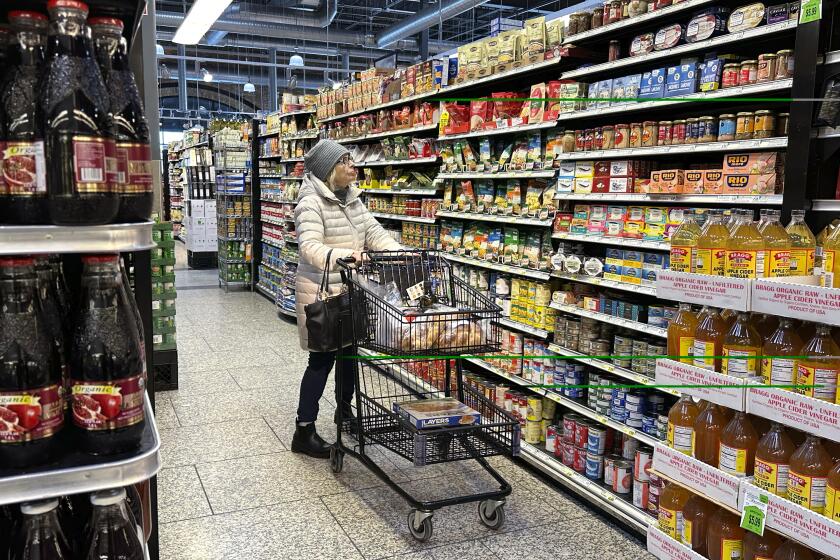California breathes sigh of relief with delayed tariffs on Mexico and Canada. China remains in play

- Share via
WASHINGTON — With President Trump’s last-minute decision to delay hefty tariffs on imports from Mexico for at least a month, the U.S. averted, or at least deferred, a potentially disastrous trade war with its biggest — and fastest growing — partner.
The delay is good news for California.
As imports from China have fallen sharply since Trump’s first barrage of tariffs against that country in 2018, virtually all of that slack has been picked up by a dramatic increase of goods from Mexico, according to U.S. trade statistics. Some of that gain is the result of multinational companies having shifted production from China to Mexico.
China still leads all nations in sending products to California, but imports from Mexico have surged by 40% since 2018 while Chinese merchandise entering California has fallen by 25%. For exports, Mexico is by far California’s top market, and Canada is No. 2, ahead of China.
On Monday, Canada won a similar reprieve as the one granted Mexico when the U.S. said it would hold off for at least a month on imposing 25% tariffs on products from its northern neighbor as well. The deal leaves just China among the original three targets still facing the immediate threat of tariffs as Trump’s plan to impose 10% additional duties on goods from that country was scheduled to take effect at midnight Tuesday. China was preparing to talk about trade with Trump.
Donald Trump’s proposed tariffs could have major consequences for California’s economy, which has a lot riding on trade, especially with China and Mexico.
The sudden turnaround by the White House suggests that Trump’s potentially catastrophic economic threats against allies and others may largely be a negotiating tactic and a form of political theater.
The threats serve to bolster his image as a tough, take-no-prisoners champion of U.S. interests while avoiding costly consequences that would alienate voters.
Earlier Monday, U.S. stocks tumbled and then quickly recovered after Trump confirmed he would postpone imposing tariffs on Mexico for a month. He said the delay was based on an agreement with Mexican President Claudia Sheinbaum that the two countries would take joint measures to fight the flow of fentanyl across the U.S. border.
The Dow Jones industrial average opened about 500 points lower after stock markets in Asia, led by Japan, fell sharply overnight. European stocks dropped as well. The Dow ended modestly lower.
But even before the deal with Mexico, financial markets did not indicate panic, suggesting that many had hoped that Trump could pull back or delay his planned tariffs, if only because the sweeping levies would probably stifle economic growth, lead to higher prices and hurt jobs.
Before the deal to avert tariffs was reached, Canada had on Sunday announced retaliatory tariffs on the U.S. , targeting farm goods and other products in Republican-led states for maximum political impact. Mexico and China had also said they were preparing countermeasures.
Mexican President Claudia Sheinbaum and Canadian Prime Minister Justin Trudeau said Monday that their countries have avoided hefty U.S. tariffs — for now.
Whether Trump is using the tariff sword purely as leverage or intends to use it, what’s clear is that the U.S. and its trading partners are entering a period of extreme uncertainty.
If the tariffs and countermeasures expected by its trading partners ultimately take effect, there probably will be chaos at the borders as many companies and government agencies seem unprepared for the sudden imposition of new rules. If a trade war ensues, it will undoubtedly be costly to all sides, at least in the immediate future and probably the longer run.
Besides significant disruptions to supply chains, countertariffs from trading partners will hurt American exporters. While tariffs on U.S. exports of things such as liquor and soybeans will hit red-state economies, California will feel the pain in slower sales of auto parts and electronics, among other goods, and seaports and logistics industries up and down the state will be affected by decreasing Chinese shipments.
U.S. trade with Mexico, Canada and China topped $2.1 trillion in 2023 — or about 42% of the total with all nations — involving practically every kind of product under the sun.
Although Canada and Mexico are more vulnerable as they depend heavily on exports to the U.S., the three North American economies are deeply integrated, particularly when it comes to auto production and trade in farm goods.
Analysts warn that U.S. consumers will see higher prices at grocery stores within days, and as inventories of cars and other consumer goods are depleted, businesses are expected to pass on the higher cost to consumers.
Cars, apparel, electronics and more could see prices go up if President-elect Donald Trump follows through on his pledge to impose sweeping new tariffs on imports from Mexico, Canada and China.
Mexican exports to the U.S. reached $475 billion in 2023, with 13%, or about $62 billion, shipped to California. The growth has come in all kinds of products across many industries, led by almost $15 billion in transportation equipment and $13.5 billion in computer and electronic products, according to 2023 data.
That year, Mexico’s shipments to California also included $7 billion worth of farm goods, $3 billion in machinery, $1 billion of Mexican oil and gas, and $664 million in apparel as many Los Angeles firms moved sewing and cutting jobs south of the border.
Canada’s exports to California have fallen off in the last couple of years, but it remains a significant supplier of oil and gas, food products and transportation equipment.
While tariffs on imports from Canada would hurt California, analysts say they’re just as much if not more worried about retaliatory tariffs, which would hurt key export industries.
California mostly exports a mix of electronics products and agricultural commodities to Canada. Through November, last year’s exports totaled $17 billion. The top three categories were all electronics such as phones and computers, followed by civilian aircraft, engines and parts, and then electric vehicles, according to trade economist Jock O’Connell’s analysis of U.S. statistics.
He said California also sent $310 million worth of lithium batteries, $308 million worth of strawberries and $333 million worth of wine to its northern neighbor. Canada said its countertariffs would include things such as tomatoes, rice, citrus fruits, nuts and wines.
“Interestingly,” O’Connell said, “the category of wines to be targeted by Canada seems to restrict the tariff to wines with an alcohol content not exceeding 13.7%.
“I’m not sure the reds being produced in Napa and Sonoma these days are that weak,” he added. “Perhaps this is a carve-out intended not to penalize a blue-state product.”
The 10% tariffs on Chinese goods would exacerbate the decline in shipments from China arriving at the Port of Los Angeles, the nation’s largest container seaport.
Sung Won Sohn, professor of finance and economics at Loyola Marymount University, said Silicon Valley relies heavily on Chinese electronics, components and manufacturing. Higher tariffs on semiconductors, computer parts and smartphones would increase costs for companies such as Apple, Tesla and Intel. And many tech startups depend on Chinese suppliers, making it harder to compete, he said.
And many California businesses import clothing, furniture and electronics from China. Retail giants such as Target, Walmart and Amazon would face higher costs, passing these on to consumers. Small businesses that depend on low-cost Chinese goods could struggle to remain profitable, Sohn said.
More to Read
Inside the business of entertainment
The Wide Shot brings you news, analysis and insights on everything from streaming wars to production — and what it all means for the future.
You may occasionally receive promotional content from the Los Angeles Times.














